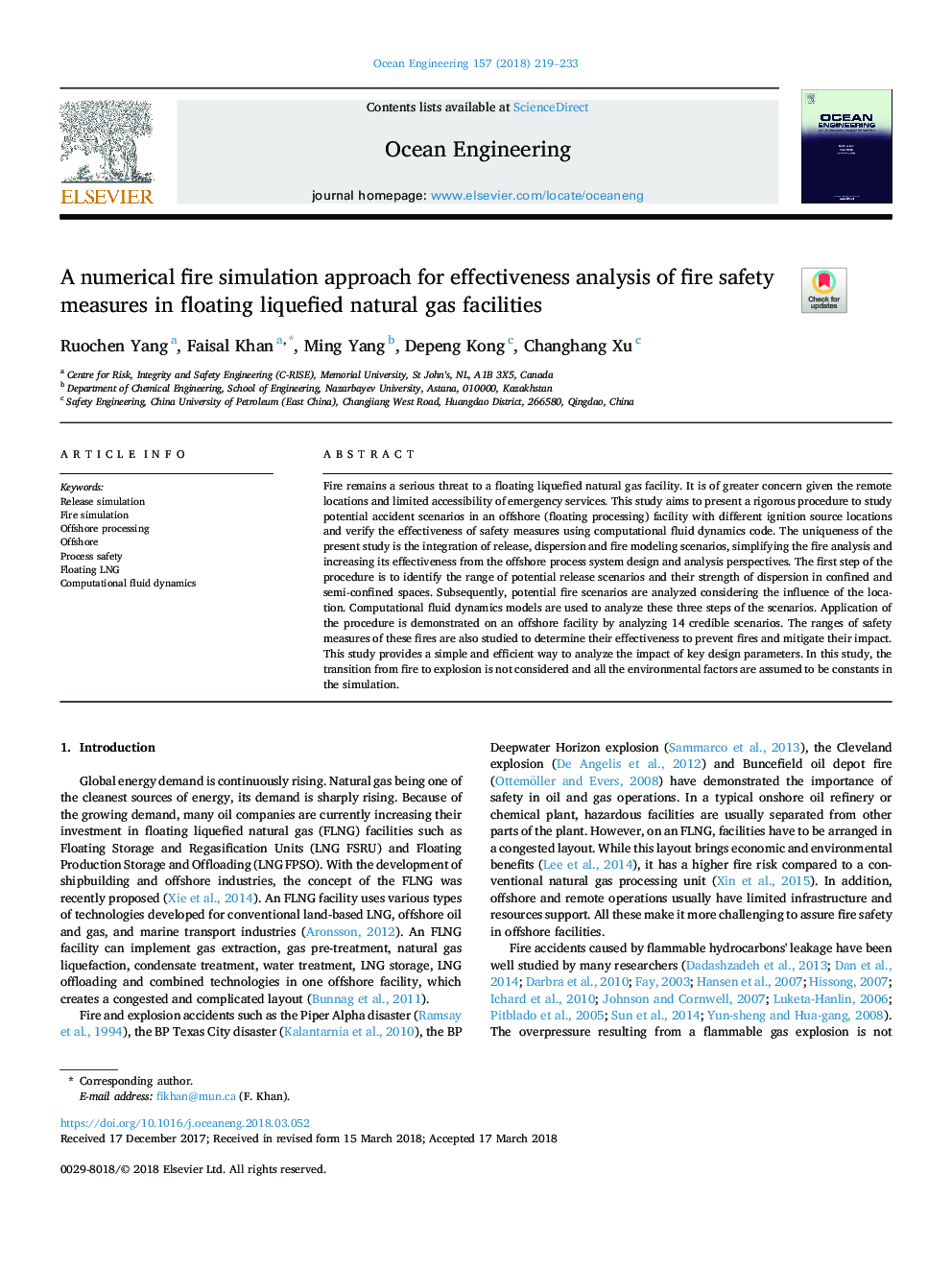| کد مقاله | کد نشریه | سال انتشار | مقاله انگلیسی | نسخه تمام متن |
|---|---|---|---|---|
| 8062540 | 1520633 | 2018 | 15 صفحه PDF | دانلود رایگان |
عنوان انگلیسی مقاله ISI
A numerical fire simulation approach for effectiveness analysis of fire safety measures in floating liquefied natural gas facilities
ترجمه فارسی عنوان
یک روش شبیه سازی آتش عددی برای تحلیل اثربخشی اقدامات ایمنی آتشسوزی در تاسیسات گاز طبیعی شناور مایع
دانلود مقاله + سفارش ترجمه
دانلود مقاله ISI انگلیسی
رایگان برای ایرانیان
کلمات کلیدی
ترجمه چکیده
آتش سوزی یک تهدید جدی برای یک تاسیسات گاز طبیعی مایع شناور است. با توجه به مکان های دور افتاده و دسترسی محدود به خدمات اورژانسی، نگرانی بیشتر است. این مطالعه با هدف ارائه یک روش دقیق برای مطالعه سناریوهای احتمالی حادثه در یک تاسیسات دریایی (پردازش شناور) با مکان های مختلف احتراق و بررسی اثربخشی اقدامات ایمنی با استفاده از کد دینامیکی سیالات محاسباتی. منحصر به فرد بودن این مطالعه، ادغام سناریوهای انتشار، پراکندگی و آتش سوزی، ساده سازی تحلیل آتش و افزایش اثربخشی آن از منظر طراحی و تحلیل سیستم فرآیندهای دریایی است. اولین گام روش این است که شناسایی طیف وسیعی از سناریوهای انتشار آزاد و قدرت پراکندگی آنها در فضاهای محدود و نیمه محدود. درنتیجه، سناریوهای بالقوه آتش سوزی با توجه به تأثیر مکان، تجزیه و تحلیل می شوند. مدل های پویایی سیالات محاسباتی برای تحلیل این سه مرحله از سناریوها استفاده می شود. با استفاده از تحلیل 14 سناریو معتبر، کاربرد این روش در یک مرکز دریایی نشان داده شده است. محدوده اندازه گیری های ایمنی این آتش سوزی همچنین برای بررسی اثربخشی آنها برای جلوگیری از آتش سوزی و کاهش تاثیر آنها مورد مطالعه قرار گرفته است. این مطالعه یک روش ساده و کارآمد برای تحلیل تاثیر پارامترهای طراحی کلیدی را فراهم می کند. در این مطالعه، گذار از آتش به انفجار در نظر گرفته نشده و تمام عوامل محیطی فرض شده است ثابت در شبیه سازی.
موضوعات مرتبط
مهندسی و علوم پایه
سایر رشته های مهندسی
مهندسی دریا (اقیانوس)
چکیده انگلیسی
Fire remains a serious threat to a floating liquefied natural gas facility. It is of greater concern given the remote locations and limited accessibility of emergency services. This study aims to present a rigorous procedure to study potential accident scenarios in an offshore (floating processing) facility with different ignition source locations and verify the effectiveness of safety measures using computational fluid dynamics code. The uniqueness of the present study is the integration of release, dispersion and fire modeling scenarios, simplifying the fire analysis and increasing its effectiveness from the offshore process system design and analysis perspectives. The first step of the procedure is to identify the range of potential release scenarios and their strength of dispersion in confined and semi-confined spaces. Subsequently, potential fire scenarios are analyzed considering the influence of the location. Computational fluid dynamics models are used to analyze these three steps of the scenarios. Application of the procedure is demonstrated on an offshore facility by analyzing 14 credible scenarios. The ranges of safety measures of these fires are also studied to determine their effectiveness to prevent fires and mitigate their impact. This study provides a simple and efficient way to analyze the impact of key design parameters. In this study, the transition from fire to explosion is not considered and all the environmental factors are assumed to be constants in the simulation.
ناشر
Database: Elsevier - ScienceDirect (ساینس دایرکت)
Journal: Ocean Engineering - Volume 157, 1 June 2018, Pages 219-233
Journal: Ocean Engineering - Volume 157, 1 June 2018, Pages 219-233
نویسندگان
Ruochen Yang, Faisal Khan, Ming Yang, Depeng Kong, Changhang Xu,
